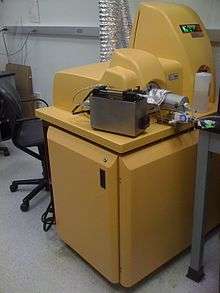Mass cytometry
Mass cytometry is a mass spectrometry technique based on inductively coupled plasma mass spectrometry and time of flight mass spectrometry used for the determination of the properties of cells (cytometry).[1][2] In this approach, antibodies are conjugated with isotopically pure elements, and these antibodies are used to label cellular proteins. Cells are nebulized and sent through an argon plasma, which ionizes the metal-conjugated antibodies. The metal signals are then analyzed by a time-of-flight mass spectrometer. The approach overcomes limitations of spectral overlap in flow cytometry by utilizing discrete isotopes as a reporter system instead of traditional fluorophores which have broad emission spectra.[3]

Commercialization
Tagging technology and instrument development occurred at the University of Toronto and DVS Sciences, Inc.[1][4] CyTOF (cytometry by time of flight) was initially commercialized by DVS Sciences in 2009. In 2014, Fluidigm acquired DVS Sciences [5] to become a reference company in single cell technology.[6] The CyTOF, CyTOF2, and Helios (CyTOF3) have been commercialized up to now. Fluidigm sells a variety of commonly used metal-antibody conjugates, and an antibody conjugation kit.
Data analysis
Mass cytometry data is recorded in tables that list, for each cell, the signal detected per channel, which is proportional to the number of antibodies tagged with the corresponding channel's isotope bound to that cell. These data are formatted as FCS files, which are compatible with traditional flow cytometry software. Due to the high-dimensional nature of mass cytometry data, novel data analysis tools have been developed as well.[7]
Advantages and disadvantages
Advantages include minimal overlap in metal signals meaning the instrument is theoretically capable of detecting 100 parameters per cell, entire cell signaling networks can be inferred organically without reliance on prior knowledge, and one well-constructed experiment produces large amounts of data.[8]
Disadvantages include the practical flow rate is around 500 cells per second versus several thousand in flow cytometry, current chemical methods limit cytometer use to around 40 parameters per cell, and CyTOF is much more expensive to own and operate. Additionally, mass cytometry is a destructive method and cells cannot be sorted for further analysis.
Applications
Mass cytometry has research applications in medical fields including immunology, hematology, and oncology. It has been used in studies of hematopoiesis,[9] cell cycle,[10] cytokine expression, and differential signaling responses.
References
- Bandura, DR; Baranov VI; Ornatsky OI; Antonov A; Kinach R; Lou X; Pavlov S; Vorobiev S; Dick JE; Tanner SD (2009). "Mass Cytometry: Technique for Real Time Single Cell Multitarget Immunoassay Based on Inductively Coupled Plasma Time-of-Flight Mass Spectrometry". Analytical Chemistry. 81 (16): 6813–6822. doi:10.1021/ac901049w. PMID 19601617.
- Di Palma, Serena; Bodenmiller, Bernd (2015). "Unraveling cell populations in tumors by single-cell mass cytometry". Current Opinion in Biotechnology. 31: 122–129. doi:10.1016/j.copbio.2014.07.004. ISSN 0958-1669.
- Spitzer, Matthew H.; Nolan, Garry P. (2016-05-05). "Mass Cytometry: Single Cells, Many Features". Cell. 165 (4): 780–791. doi:10.1016/j.cell.2016.04.019. ISSN 1097-4172. PMC 4860251. PMID 27153492.
- Ornatsky, O; Bandura D; Baranov V; Nitz M; Winnick MA; Tanner S (30 September 2010). "Highly multiparametric analysis by mass cytometry". Journal of Immunological Methods. 361 (1–2): 1–20. doi:10.1016/j.jim.2010.07.002. PMID 20655312.
- "Fluidigm | Press Releases | FLUIDIGM TO ACQUIRE DVS SCIENCES". www.fluidigm.com. Retrieved 2015-11-11.
- "An Open Letter to Customers of Fluidigm and DVS Sciences, Inc" (PDF). Fluidigm and DVS Sciences, Inc. 13 February 2014. Retrieved 4 July 2014.
- Krishnaswamy, Smita; Spitzer, Matthew; Mingueneau, Michael; Bendall, Sean; Litvin, Oren; Stone, Erica; Pe'er, Dana; Nolan, Garry (28 Nov 2014). "Conditional density-based analysis of T cell signaling in single-cell data". Science. 346 (6213): 1250689. doi:10.1126/science.1250689. PMC 4334155. PMID 25342659.
- Spitzer, Matthew H.; Nolan, Garry P. (2016). "Mass Cytometry: Single Cells, Many Features". Cell. 165 (4): 780–791. doi:10.1016/j.cell.2016.04.019. ISSN 0092-8674. PMC 4860251. PMID 27153492. no-break space character in
|first1=at position 8 (help); no-break space character in|first2=at position 6 (help) - Bendall SC, Simonds EF, Qiu P, Amir El-ad D, Krutzik PO, Finck R, Bruggner RV, Melamed R, Trejo A, Ornatsky OI, Balderas RS, Plevritis SK, Sachs K, Pe'er D, Tanner SD, Nolan GP (2011). "Single-cell mass cytometry of differential immune and drug responses across a human hematopoietic continuum". Science. 332 (6030): 687–96. Bibcode:2011Sci...332..687B. doi:10.1126/science.1198704. PMC 3273988. PMID 21551058.
- Behbehani, Gregory K.; Bendall, Sean C.; Clutter, Matthew R.; Fantl, Wendy J.; Nolan, Garry P. (2012-07-01). "Single-cell mass cytometry adapted to measurements of the cell cycle". Cytometry Part A. 81 (7): 552–566. doi:10.1002/cyto.a.22075. ISSN 1552-4930. PMC 3667754. PMID 22693166.